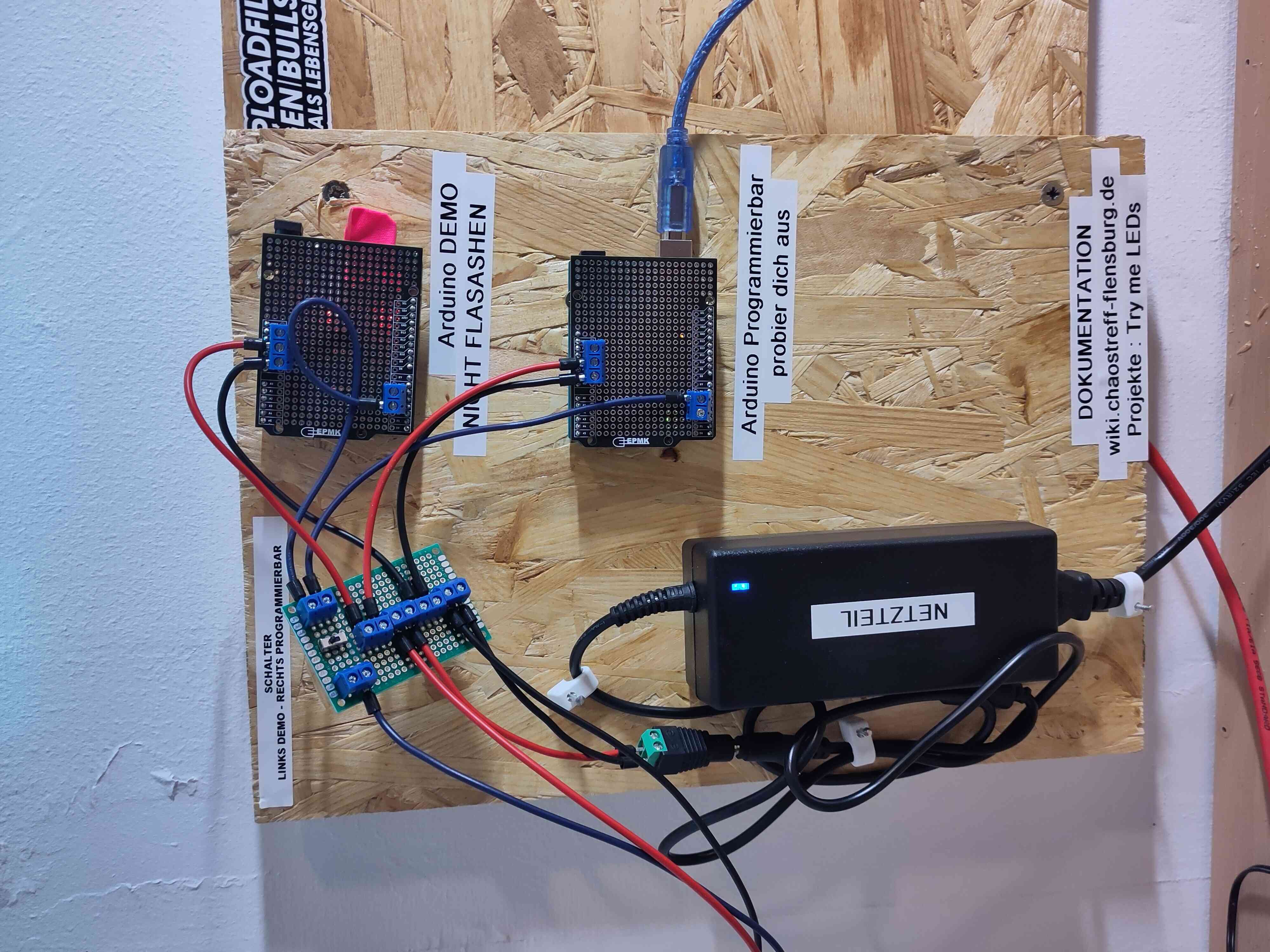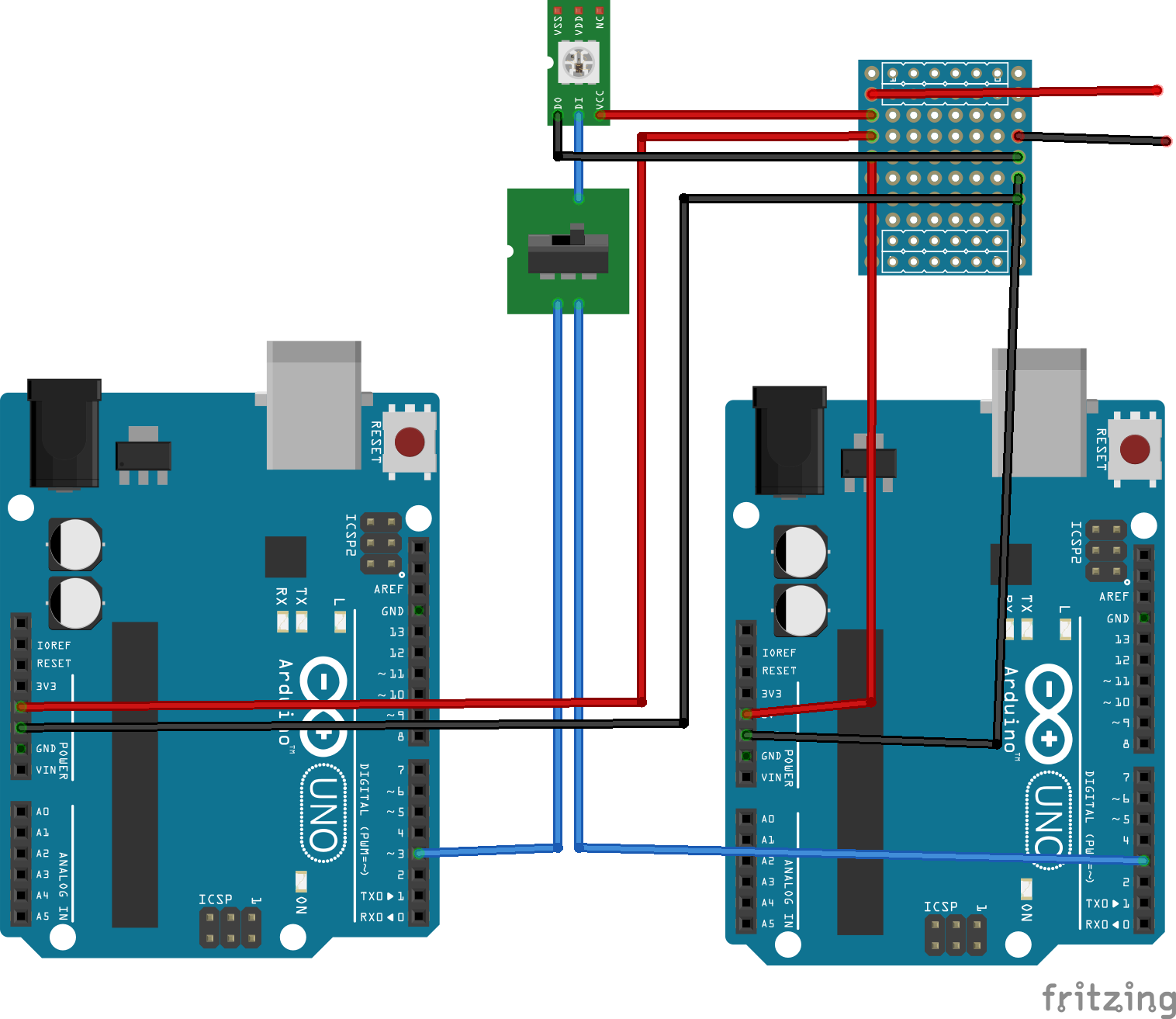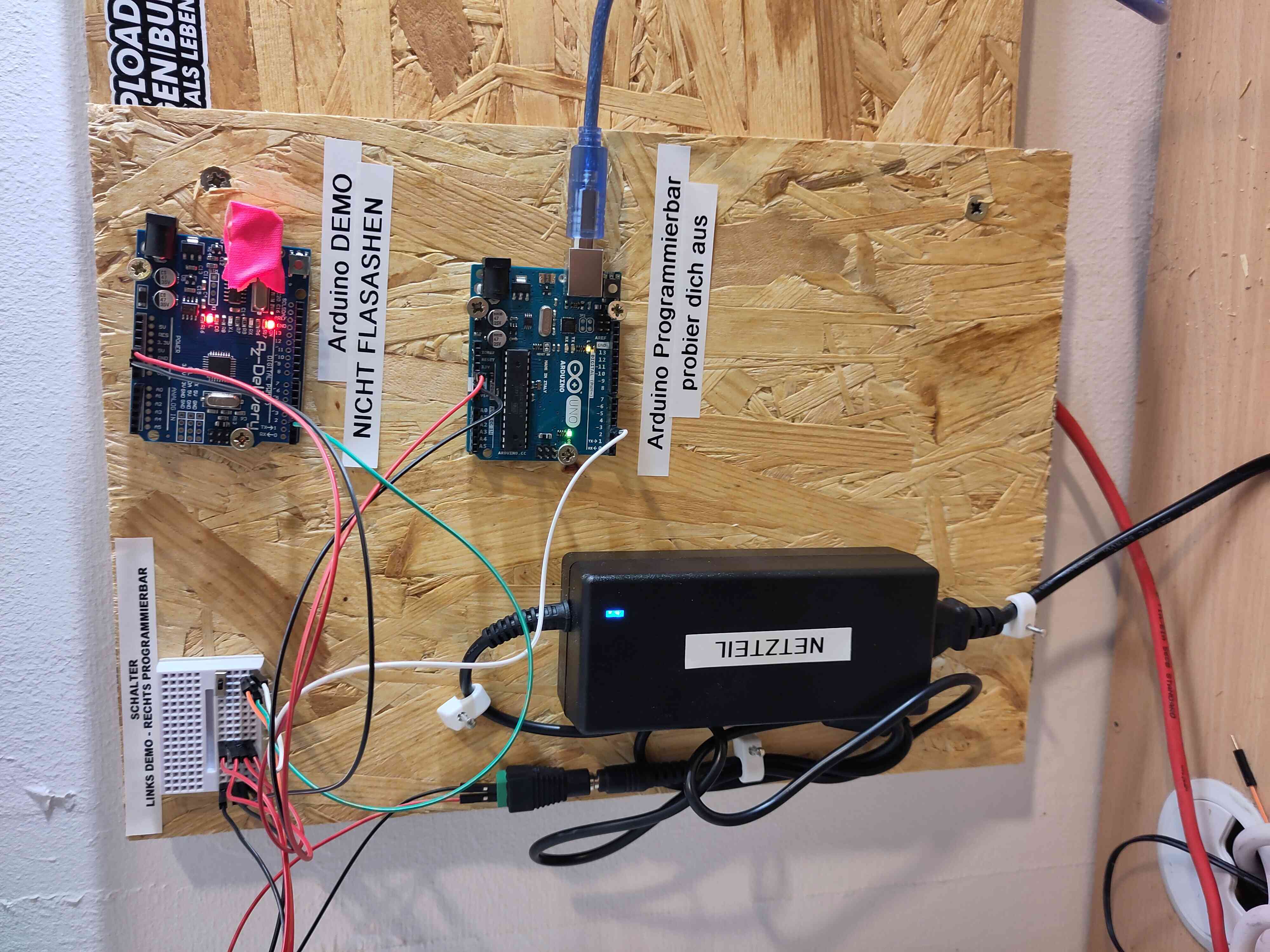Edit on Github
Tags:
Try me LEDs

Try me LEDs
- Ansprechpartner*innen
Mit den Try me LEDs kannst du spielerisch deine Fähigkeiten im Programmieren von LEDs ausprobieren.
Du kannst den “Arduino Programmierbar” einfach mit deinem Skript programmieren. Am besten verwendest du dazu die Fastled Bibliothek. Oben auf dem “Schalter” kannst du einstellen, welcher Arduino den LED-Streifen programmiert. Auf dem “Arduino Demo” läuft immer das Fastled Demo Script.
Das Netzteil hat einen Output von 5V 10A
Weitere Resourcen
Beispiel Code zwei Durchlaufende LEDs
#include <FastLED.h>
// How many leds in your strip?
#define NUM_LEDS 300
#define BRIGHTNESS 55
#define DATA_PIN 3
// Define the array of leds
CRGB leds[NUM_LEDS];
void setup() {
// Uncomment/edit one of the following lines for your leds arrangement.
// ## Clockless types ##
FastLED.addLeds<NEOPIXEL, DATA_PIN>(leds, NUM_LEDS); // GRB ordering is assumed
FastLED.setBrightness(BRIGHTNESS );
}
void loop() {
// Turn the LED on, then pause
for (int i = 0; i <= NUM_LEDS; i++) {
leds[i-2] = CRGB::Black;
leds[i-1] = CRGB::Black;
leds[i] = CRGB::Green;
leds[i+1] = CRGB::Green;
FastLED.show();
delay(50);
}
}
Verbindung

Historie
Aller erste Version:

LEDs mit Potentiometer
Schließe einen Potentiometer an den A0 (Analog 0) Pin und ändere dann folgenden Code:
void loop() {
for (int i = 0; i <= NUM_LEDS; i++) {
leds[i-2] = CRGB::Black;
leds[i-1] = CRGB::Black;
leds[i] = CRGB::Green;
leds[i+1] = CRGB::Green;
FastLED.show();
// map(value, fromLow, fromHigh, toLow, toHigh)
delay(map(analogRead(A0), 0, 255, 0, 400));
Serial.println(A0);
}
}
map() infos in der Arduino Doku
DemoReel 100 auf dem “Arduino DEMO”
/// @file DemoReel100.ino
/// @brief FastLED "100 lines of code" demo reel, showing off some effects
/// @example DemoReel100.ino
#include <FastLED.h>
FASTLED_USING_NAMESPACE
// FastLED "100-lines-of-code" demo reel, showing just a few
// of the kinds of animation patterns you can quickly and easily
// compose using FastLED.
//
// This example also shows one easy way to define multiple
// animations patterns and have them automatically rotate.
//
// -Mark Kriegsman, December 2014
#define DATA_PIN 3
//#define CLK_PIN 4
#define LED_TYPE WS2812
#define COLOR_ORDER GRB
#define NUM_LEDS 300
CRGB leds[NUM_LEDS];
#define BRIGHTNESS 96
#define FRAMES_PER_SECOND 120
void setup() {
delay(3000); // 3 second delay for recovery
// tell FastLED about the LED strip configuration
FastLED.addLeds<LED_TYPE,DATA_PIN,COLOR_ORDER>(leds, NUM_LEDS).setCorrection(TypicalLEDStrip);
//FastLED.addLeds<LED_TYPE,DATA_PIN,CLK_PIN,COLOR_ORDER>(leds, NUM_LEDS).setCorrection(TypicalLEDStrip);
// set master brightness control
FastLED.setBrightness(BRIGHTNESS);
FastLED.setMaxPowerInVoltsAndMilliamps(5,8000);
}
// List of patterns to cycle through. Each is defined as a separate function below.
typedef void (*SimplePatternList[])();
SimplePatternList gPatterns = { rainbow, rainbowWithGlitter, confetti, sinelon, juggle, bpm };
uint8_t gCurrentPatternNumber = 0; // Index number of which pattern is current
uint8_t gHue = 0; // rotating "base color" used by many of the patterns
void loop()
{
// Call the current pattern function once, updating the 'leds' array
gPatterns[gCurrentPatternNumber]();
// send the 'leds' array out to the actual LED strip
FastLED.show();
// insert a delay to keep the framerate modest
FastLED.delay(1000/FRAMES_PER_SECOND);
// do some periodic updates
EVERY_N_MILLISECONDS( 20 ) { gHue++; } // slowly cycle the "base color" through the rainbow
EVERY_N_SECONDS( 10 ) { nextPattern(); } // change patterns periodically
}
#define ARRAY_SIZE(A) (sizeof(A) / sizeof((A)[0]))
void nextPattern()
{
// add one to the current pattern number, and wrap around at the end
gCurrentPatternNumber = (gCurrentPatternNumber + 1) % ARRAY_SIZE( gPatterns);
}
void rainbow()
{
// FastLED's built-in rainbow generator
fill_rainbow( leds, NUM_LEDS, gHue, 7);
}
void rainbowWithGlitter()
{
// built-in FastLED rainbow, plus some random sparkly glitter
rainbow();
addGlitter(80);
}
void addGlitter( fract8 chanceOfGlitter)
{
if( random8() < chanceOfGlitter) {
leds[ random16(NUM_LEDS) ] += CRGB::White;
}
}
void confetti()
{
// random colored speckles that blink in and fade smoothly
fadeToBlackBy( leds, NUM_LEDS, 10);
int pos = random16(NUM_LEDS);
leds[pos] += CHSV( gHue + random8(64), 200, 255);
}
void sinelon()
{
// a colored dot sweeping back and forth, with fading trails
fadeToBlackBy( leds, NUM_LEDS, 20);
int pos = beatsin16( 13, 0, NUM_LEDS-1 );
leds[pos] += CHSV( gHue, 255, 192);
}
void bpm()
{
// colored stripes pulsing at a defined Beats-Per-Minute (BPM)
uint8_t BeatsPerMinute = 62;
CRGBPalette16 palette = PartyColors_p;
uint8_t beat = beatsin8( BeatsPerMinute, 64, 255);
for( int i = 0; i < NUM_LEDS; i++) { //9948
leds[i] = ColorFromPalette(palette, gHue+(i*2), beat-gHue+(i*10));
}
}
void juggle() {
// eight colored dots, weaving in and out of sync with each other
fadeToBlackBy( leds, NUM_LEDS, 20);
uint8_t dothue = 0;
for( int i = 0; i < 8; i++) {
leds[beatsin16( i+7, 0, NUM_LEDS-1 )] |= CHSV(dothue, 200, 255);
dothue += 32;
}
}
Sonstiges
Tags: